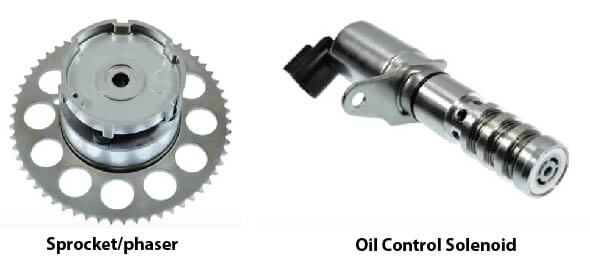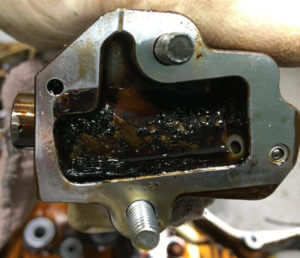P1345 crankshaft/camshaft position sensor correlation
Diagnose and fix a P1345 trouble code
A P1345 trouble code is an “enhanced” or “manufacturer-specific” code and may not be read by code readers or scan tools that read only generic OBDII trouble codes. If you have this code, do NOT start replacing parts!!!
What a P1345 code means
The powertrain control module (PCM) compares the crankshaft position (CKP) sensor data to the camshaft position (CMP) sensor information to ensure the two shafts are where the PCM expects them to be. This is especially important on vehicles with variable valve timing (VVT).
What is variable valve timing?
Variable valve timing mechanisms are capable of advancing and retarding camshaft timing on the fly to match driver input for power, while maintaining proper emissions. There are two basic types of VVT systems: sprocket/phaser and valve lift.
Sprocket/phaser VVT system
Most domestic car makers use this system. Sprocket/phaser systems use two devices. The sprocket/phaser replaces the traditional camshaft gear used at the end of the camshaft. Just like an ordinary camshaft gear, the sprocket/phaser connects to the timing chain to rotate the camshaft. While the outer sprocket is rotated by the timing chain, the inner portion can advance or retard the camshaft based on oil pressure fed to an internal cylinder by the oil control solenoid.

Sprocket/phaser and oil control solenoid
The oil control solenoid is connected to a main oil gallery. The PCM uses the oil control solenoid to regulate oil pressure into the sprocket/phaser. The regulation is performed by pulse width modulation, a technique that varies the valve open versus valve closed time by connecting and disconnecting the ground portion of the solenoid circuit. For example, a PCM may connect the ground side of the circuit (which opens the solenoid passages) for 5/10ths of a second and disconnects it for 5/10ths of a second to achieve a 50% duty cycle.
Valve lift VVT systems
Honda calls this their VTEC system. Some version of valve rocker or valve follower lift is used by other Japanese and European car makers, this system uses a camshaft with more lobes. The system may have multiple rocker arms for a single cylinder. The valve lift system uses oil pressure to lift a rocker arm off the camshaft, thereby disabling or changing the valve open/close timing for a particular valve.
An oil control valve is used to operate the valve lift mechanism and it can be a simple on/off or pulse width modulated system.
What goes wrong with VVT systems?
Whether your vehicle uses the sprocket/phaser or valve lift method, the oil control solenoid is the critical component and the one most likely to fail. Why? Because it’s entire operation is based on the assumption that you’ve used the correct oil viscosity and change your oil according the car maker’s recommendations.
When the PCM commands a duty cycle to the oil control solenoid, it does so knowing that a certain oil viscosity at a known pressure will advance or retard or lift a rocker by a known amount. If you use a different oil viscosity or extend your oil change intervals, you change the amount of advance or retard. That discrepancy results in a P1345 correlation trouble code
Most cam phaser oil control solenoids fail because of sludge
Oil control solenoids have intricate

Sludge in VVT oil control solenoid screen
machined passages that can’t tolerate particulate matter. So they’re built with filtering screens. Plugged screens, “blown out” screens due to dirty oil are the #1 cause of oil control solenoid failure.
Oil changes directly affect the life of the oil control valve
You may think you’re diligent about oil changes. But the part you’re missing is that oil life is based on more than mileage. It’s based on HOW you drive and how often you check your oil level.
All engines use oil. If you change your oil every 7,000 miles but never check the oil level in between changes, you’re setting yourself up for engine problems caused by sludge buildup. That’s because your engine may burn a quart of oil during that 7,000 mile interval, putting the remaining oil under severe stress. Burning a quart of oil in an engine that holds 4.5 quarts, reduces remaining oil life by at least 25%. In other words, you were due for an oil change at 5,250 miles, but you kept driving an additional 1,750 on exhausted oil.
Conditions for setting the P1345 trouble code
• The engine has been running for more than 16 seconds.
• The minimum voltage is 11 volts.
• The variable camphaser is commanded to zero.
• The deviation between the crankshaft and the camshaft positions exceeds a calibrated amount.
• The camphaser solenoid stuck open
• The camphaser stuck in a position other than 0 degrees
• The camphaser does not return to 0 degrees within 16 seconds
Symptoms of a P1345 trouble code
• Check engine light on
• Rough idle
• Stalling
• Lack of power
• Engine noise/rattling
Primary causes of P1345
• Sludge buildup in the oil control solenoid
• Plugged screen in the oil control solenoid
• A loose or missing crank damper bolt
Fix a P1345 trouble code
1). Change oil and filter
2). Remove oil control solenoid and check condition of the filter screen. If plugged, clean. If screen is blown out or missing, replace oil control solenoid.
3). Test resistance and voltage drop on oil control solenoid per shop manual specs
4). Replace oil control solenoid
©, 2018 Rick Muscoplat
Posted on by Rick Muscoplat